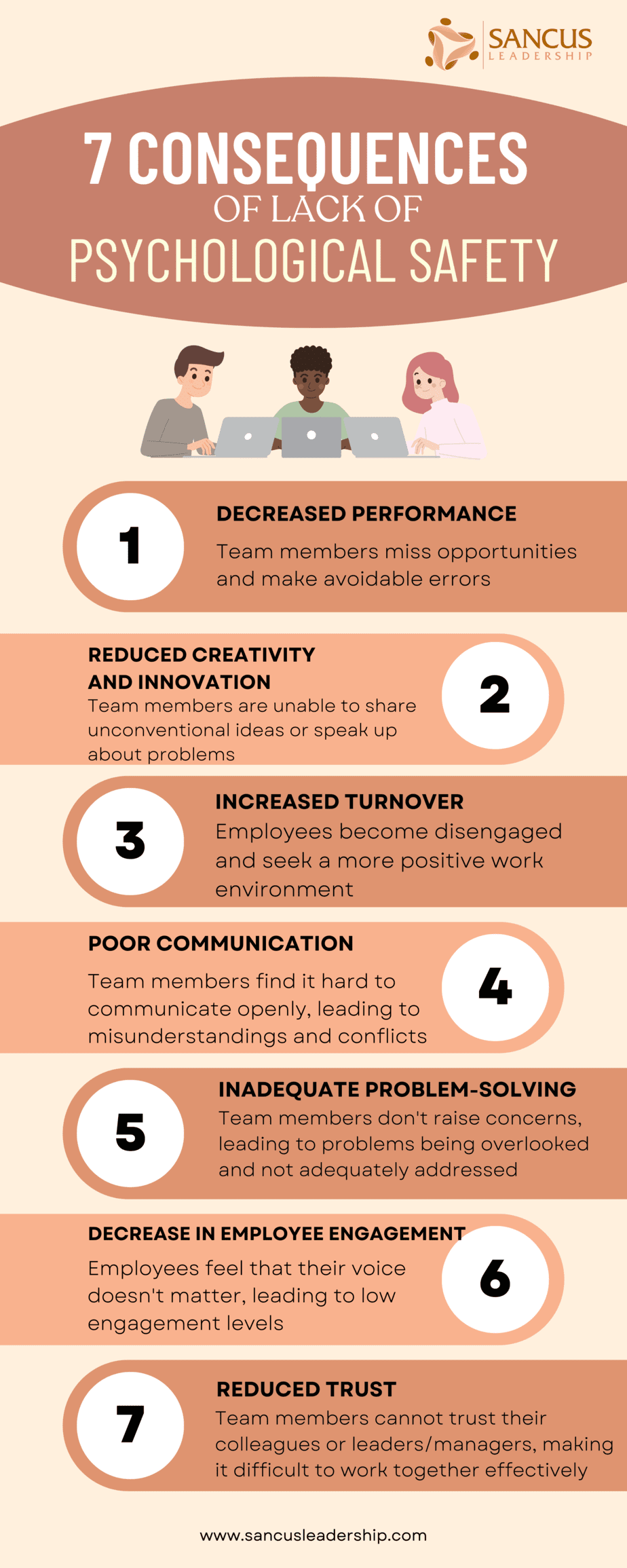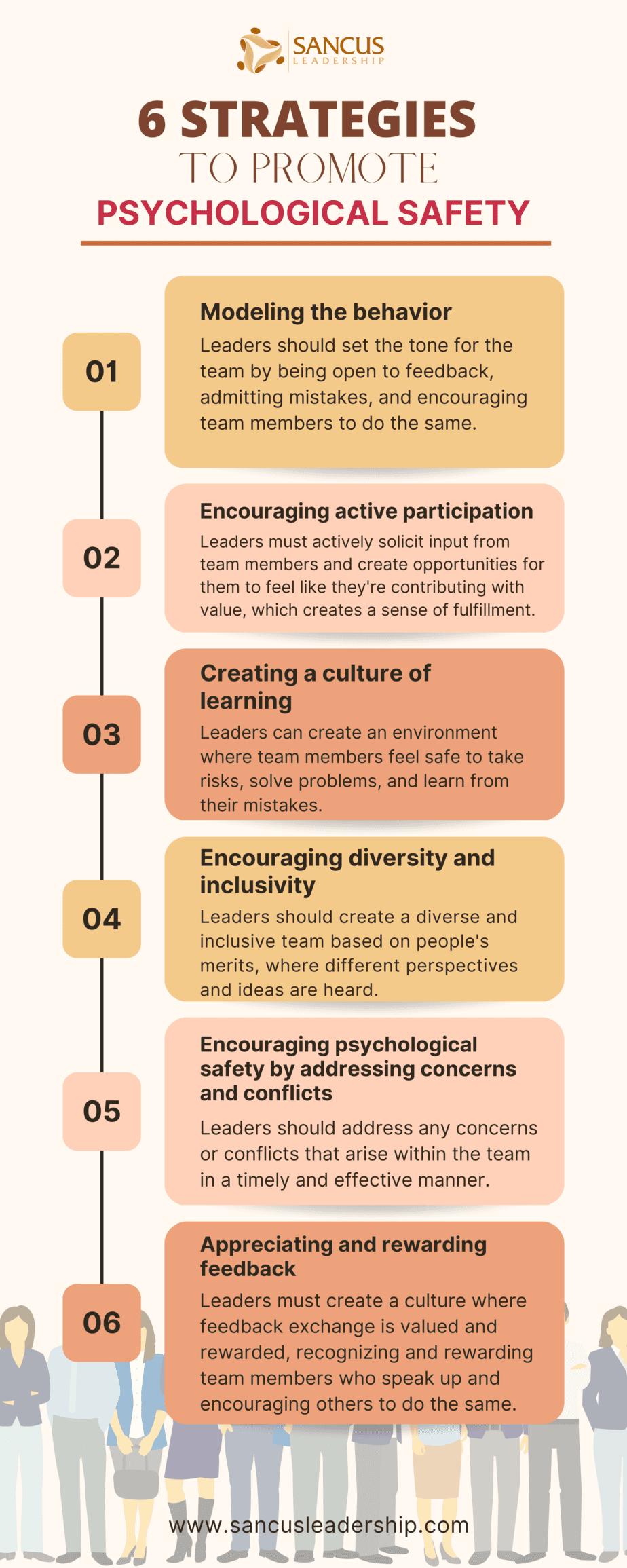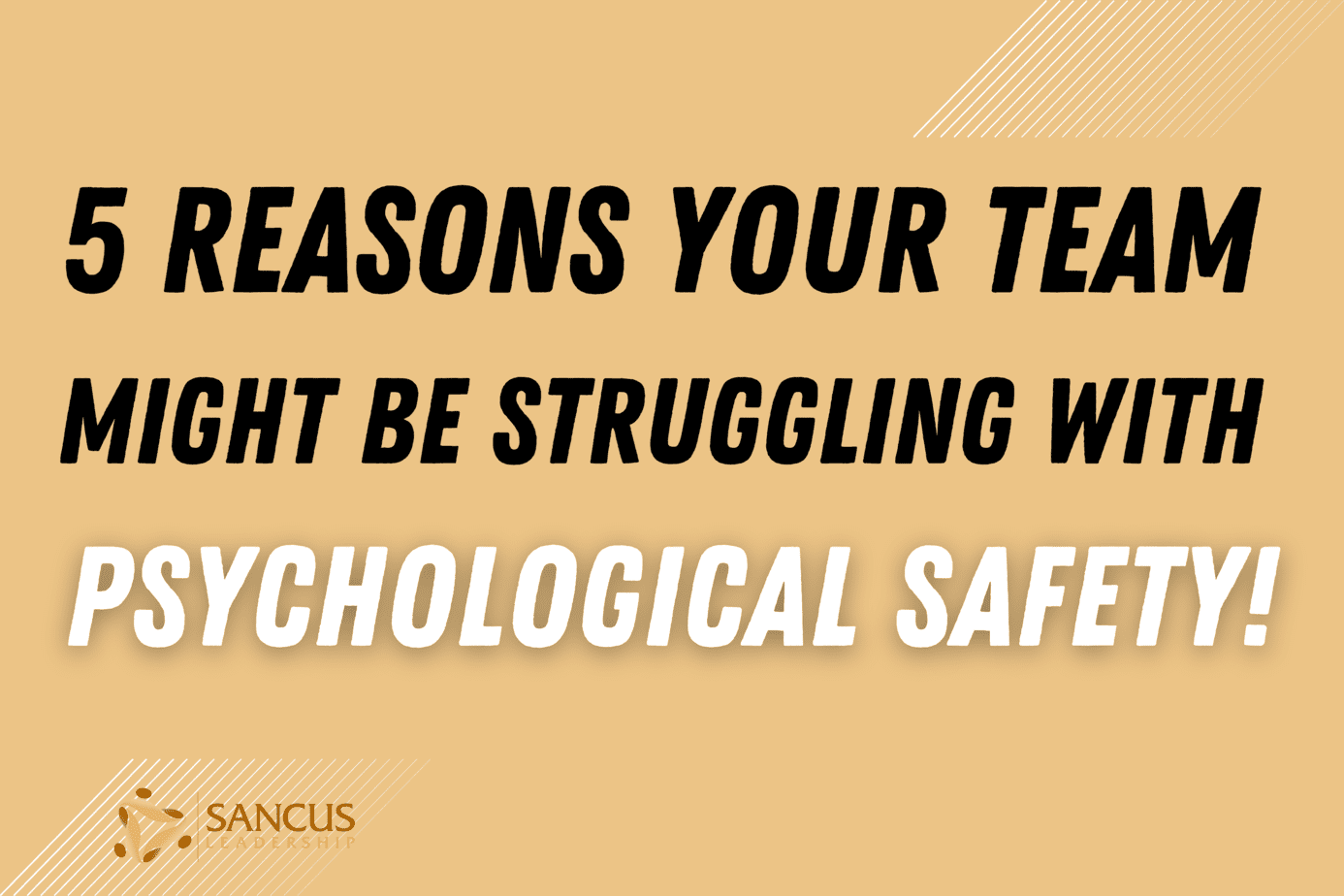One thing I hate is listening to stories where friends say they don’t feel comfortable speaking up at work. They tell me that when they do, they sometimes get ignored or belittled, causing them only to say things they know will be appreciated. They stop innovating, and they engage less with work. They move closer and closer to only doing what is necessary, never taking any risks. Their team lacks the necessary psychological safety!
Low psychological safety in a team can be caused by a lack of trust, fear of failure, lack of support, unclear expectations, and poor communication. When these factors plague the workplace, it creates an environment of low psychological safety.
As a leader or a small team member, you must be aware of these factors. In this article, I’ll explain what causes low psychological safety and how to lead and manage your team in a way that promotes high psychological safety.
What Causes Low Psychological Safety?

According to the theory of psychological safety in the workplace developed by Google engineer, Harvard Business School researcher, and author Dr. Amy Edmondson, low psychological safety can be caused by five main factors:
- Lack of trust
- Fear of failure or reprisal
- Lack of support
- Unclear expectations
- Lack of open communication
Dr. Edmondson defines psychological safety as “A shared belief held by team members that the team is safe for interpersonal risk-taking.” This means that the leaders and managers create a sense of security within their teams, allowing everyone to feel safe and fulfilled.
Let me explain the five factors that cause low psychological safety in the workplace, one by one.
Lack of Trust
When there’s a lack of trust in the workplace (here is a great way to assess trust in your team), it takes a lot of work to lead/manage a team toward success.
When everyone is keeping an eye on one another, it’s hard to be productive. Team members who don’t trust one another or feel they can’t trust their leader are less likely to speak up or share their ideas. This creates a negative environment that leads to lower and lower psychological safety.
At Sancus Leadership, we believe that trust is what separates a group of individuals from a team. Without trust, there is no team. Without a team, there is no success!
At Sancus Leadership, we believe that trust is what separates a group of individuals from a team; without trust, there is no team. Without a team, there is no success!
Fear of Failure
When there’s a high degree of fear of failure among the team members, it’s not easy to have a positive, creative environment.
If team members feel they will receive punishment or be harshly criticized for making mistakes, they’re less likely to innovate, take risks, or try new things.
Leaders who use fear to motivate the team members to work proficiently will kill creativity and innovative thinking, in addition to making the team feel psychologically insecure.
Lack of Support
When a group operates under the principle of each on their own, and no one offers support, especially the leaders and managers, a lack of emotional support plagues the work environment, creating low psychological safety.
If team members feel like they don’t have the support and resources needed to do their jobs efficiently and effectively, they are less likely to contribute fully to the group and feel at ease.
Unclear Expectations
Motivation is tightly tied to expectations. Unclear expectations are one of the leading causes of confusion in the workplace, so leaders should be explicit about what they expect from their teams. When the expectations are unclear, it creates a sense of uncertainty, hindering your team members’ motivation.
If team members are uncertain of what is expected of them or feel that expectations are unrealistic or unfair, this will create an environment of uncertainty and stress.
Setting clear expectations and delegating tasks are skillsets I see few managers master. It is up to you as a leader to communicate clearly so that your team can work as autonomously as possible toward goals and visions.
Poor Communication
Communication is a two-way stream: it’s giving and receiving. Communication breakdowns happen when the team members feel unheard or their opinions are not valued.
When the workplace is a poor communication environment that doesn’t allow everyone to be heard when needed, it creates resentment and all sorts of negative attitudes. Some of these are self-victimization, vindictiveness, and passive-aggression.
Breakdowns in communication within the team, where the team members feel that their ideas are unheard or not valued, often lead to low psychological safety.
Breakdowns in communication within the team, where the team members feel that their ideas are unheard or not valued, often lead to low psychological safety.
| Factors causing low psychological safety | Description |
| Lack of Trust | When there is a lack of trust in the workplace, team members are less likely to speak up or share their ideas, which creates a negative environment that leads to lower psychological safety. |
| Fear of Failure | When there is a high degree of fear of failure among team members, they are less likely to innovate, take risks, or try new things, which leads to a less positive and creative environment. |
| Lack of Support | When team members feel like they don’t have the support and resources needed to do their jobs efficiently and effectively, they are less likely to contribute fully to the group and feel at ease, which creates low psychological safety. |
| Unclear Expectations | When team members are uncertain of what is expected of them or feel that expectations are unrealistic or unfair, this creates an environment of uncertainty and stress, which leads to lower psychological safety. |
| Poor Communication | When there are breakdowns in communication within the team, where team members feel unheard or their opinions are not valued, it creates resentment and negative attitudes, which leads to lower psychological safety. |
Why a Team May Lack Psychological Safety

Psychological safety is the belief by team members that they feel safe in their work environment without fearing being punished or humiliated for voicing their ideas, questions, concerns, or mistakes.
If you’re interested in building a psychologically safe environment, I highly advise you to take a look at her two books: The Fearless Organization and Teaming: How Organizations Learn, Innovate, and Compete in the Knowledge Economy. You can also book a FREE psychological safety assessment call with us at Sancus Leadership.
For now, let’s look at three concrete examples of why a team might lack psychological safety.
Fear of Speaking Up
One reason that signals a lack of psychological safety is that team members are reluctant to speak up, fearing coming across as incompetent, foolish, or naive.
An example of this attitude turning into a low degree of psychological safety is when the team is in a high-pressure situation, especially when there are also high stakes and the potential consequences of making mistakes are severe.
Rigid Hierarchies
Another reason that creates a lack of psychological safety is when the leader doesn’t create a relationship of trust.
When team members cannot trust their leader to actively listen to their feedback or opinions, especially in the case of organizations with rigid hierarchies, it creates apprehension, leading to a lack of psychological safety.
Competitive Team Culture
A lack of psychological safety can be rooted in the team culture, especially in highly-competitive environments with quasi-tyrannical leaders.
On the flip side, team cultures where conflict resolutions are avoided, and criticism is not looked at favorably can also create low psychological safety.
The Consequences of Lack of Psychological Safety

A lack of psychological safety has some dire consequences, namely hindering the team’s performance, as well as their degree of engagement and creativity, which can ruin a business in the long run.
Here are the seven main consequences of working in an environment that doesn’t promote psychological safety:
- Decreased performance: When team members don’t feel psychologically safe, it can lead to missed opportunities and avoidable errors.
- Reduced creativity and innovation: A work environment that lacks psychological safety hinders the team members from sharing unconventional ideas or speaking up about problems, which renders them unable to come up with new and creative solutions.
- Increased turnover: When employees don’t feel psychologically safe, they become disengaged and eventually look for alternatives where they can find a more positive work environment.
- Poor communication: When psychological safety is lacking, team members find it hard to communicate openly, which leads to misunderstandings and unnecessary conflicts.
- Inadequate problem-solving: Without psychological safety, team members don’t feel compelled to raise concerns, which creates an attitude of willful blindness. This leads to problems being overlooked and not addressed adequately, causing negative consequences in the long term.
- Decrease in employee engagement: When employees feel that their voice doesn’t matter or that their workplace culture isn’t open for two-way feedback exchange, it can lead to low engagement levels, making them less productive and less motivated to perform well.
- Reduced trust: When team members cannot trust their colleagues or leaders/managers, it leads to a negative atmosphere in the workplace, which makes it difficult to work together effectively.

Perhaps the harmful effects of low psychological safety are felt the most during a crisis. Crises can make members afraid of the future and of losing their position in the team. If psychological safety within a team is low, a crisis can cause it to break down entirely.
What Impact Does the Team Leader Have On Psychological Safety?

According to Dr. Amy Edmondson’s research, the team leader has the most critical role in creating and maintaining psychological safety within a team.
Ultimately, a leader’s actions, attitudes, and communication style greatly influence the workplace’s psychological safety level. Fostering a culture of trust, open communication, and learning is how leaders create an environment where team members feel safe to share their thoughts and collaborate efficiently.
Here’s a YouTube video of Dr. Edmondson where she explains the importance of fostering a psychologically safe environment:
Strategies to Promote Psychological Safety in Your Team

To overcome the challenges that come with low psychological safety and create a culture where everyone feels safe, Edmondson suggests that leaders should create an environment where team members can speak up, feedback is actively sought and valued, and mistakes are seen as opportunities for learning and growth.
Here are six strategies you can start implementing in your team to promote psychological safety:

- Modeling the behavior: A leader sets the tone for the team by being open to feedback and ideas and able to admit mistakes. The leader should encourage the other team members to do the same.
- Encouraging active participation: Leaders must actively solicit input from team members and create opportunities for them to feel like they’re contributing with value, which creates a sense of fulfillment that turns into high psychological safety.
- Creating a culture of learning: Leaders can create an environment where the team members feel safe to take risks, solve problems as they arise, and learn from their mistakes.
- Encouraging diversity and inclusivity: Leaders should actively work to create a diverse and inclusive team based on people’s merits, which creates an environment where different perspectives and ideas are heard.
- Encouraging psychological safety by addressing concerns and conflicts: Leaders can also help to establish psychological safety by addressing any concerns or conflicts that arise within the team in a timely and effective manner.
- Appreciating and rewarding feedback: Leaders must create a culture where feedback exchange—positive and negative alike—is valued and rewarded. This involves recognizing and rewarding team members who speak up and encouraging others to do the same.
The Positive Effects of Promoting Psychological Safety

Teams with high levels of psychological safety are more innovative, creative, and productive. They are also more likely to thrive and feel at home working together. Such a positive atmosphere promotes fulfillment and a sense of satisfaction that motivates everyone to perform at their best.
Promoting psychological safety within a team has several positive effects:
- Increased performance: When team members feel a high degree of psychological safety, they are more likely to share important information and ideas, which leads to increased productivity and collaboration.
- Enhanced creativity and innovation: When team members feel comfortable sharing their ideas—even their unconventional opinions and strategies—they can come up with new and creative solutions, i.e., thinking outside the box.
- Improved communication: When psychological safety is present, team members feel more at ease communicating openly and honestly with one another, which leads to more efficient and effective problem-solving.
- Increased employee engagement and reduced turnover: When employees feel that they matter and that their ideas are heard, they become more engaged and committed to the team and the organization, leading to fewer resignations.
- Greater learning and improvement: When the team fosters a high degree of psychological safety, they become more likely to take risks and learn from their mistakes, leading to progressive improvement over time. This creates a sense of momentum that’s necessary for thriving in any business.
- High-quality decision-making: When the team members feel comfortable expressing their thoughts and opinions, they are likely to express diverse perspectives, leading to better decision-making by considering all the multiple viewpoints and options.
- Increased trust: When people feel that they can trust their colleagues and leaders, greater trust within the team is created, making it easier to work together as a team.
- Increased resilience: Teams with high psychological safety tend to be resilient to change, setbacks, and unexpected circumstances. They’re able to bounce back from failure quite easily.
Overall, promoting psychological safety within a team positively impacts a team’s morale. When morale is high, it’s reflected in the team’s performance, creativity, communication, and overall success. Simply put, a high degree of psychological safety leads to a more productive and positive work environment.
Final Words
Low psychological safety in the workplace is caused by various factors, including a lack of trust and fear of speaking up.
As a leader or team member, it’s important to be aware of these factors and take active steps to create a culture that promotes psychological safety. This can be achieved by managing your team in a manner that accounts for their psychological needs.



